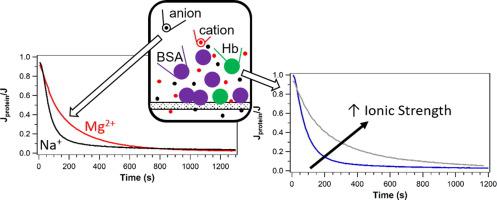Separation and Purification Technology ( IF 8.1 ) Pub Date : 2020-09-23 , DOI: 10.1016/j.seppur.2020.117769 Noah T. Kilmer , Rebecca L. Huss , Carolyn C. George , Elana M.S. Stennett

|
Studying biofouling is important for increased implementation of membrane-based water purification technologies. A binary protein solution (bovine serum albumin (BSA) and hemoglobin (Hb)) was used to study biofouling of hydrophilic and hydrophobic PVDF membranes. By fitting normalized plots of flux vs time to an exponential decay, the rate of fouling and long-term steady-state flux were compared in the presence of different ions and at different ionic strengths. The presence of ions causes a lower steady-state flux but rate effects are ion identity dependent. Equally important is membrane type. For the hydrophobic membrane, the charge of the cation dictates different mechanisms affecting the rate or steady-state flux. With the hydrophilic membrane, the presence of cations results in a direct correlation between the rate of fouling and steady-state flux while the presence of different anions leads to no apparent trends. Thus, the Hofmeister series does not explain the influence of ions on the fouling of the binary protein solution. Finally, studies at higher ionic strengths (150 – 600 mM) show that fouling rates decrease likely due to charge shielding. The ionic strength where this effect is apparent depends on ion identity. The limited flux model supports these conclusions, though membrane type is also important. Therefore, while protein-protein interactions are crucial, ion-membrane interactions cannot be ignored either. Conclusions about the role of ions and ionic strength on fouling must be made with care as multiple factors contribute to the rate and extent of fouling of a binary protein solution.
中文翻译:

离子身份和离子强度对二元蛋白溶液膜生物结垢的影响
研究生物污损对于提高基于膜的水净化技术的实施至关重要。使用二元蛋白溶液(牛血清白蛋白(BSA)和血红蛋白(Hb))研究亲水性和疏水性PVDF膜的生物污染。通过将通量与时间的标准化曲线拟合为指数衰减,可以比较存在不同离子和不同离子强度时的结垢率和长期稳态通量。离子的存在会导致较低的稳态通量,但速率效应取决于离子的身份。同样重要的是膜类型。对于疏水膜,阳离子的电荷决定了影响速率或稳态通量的不同机理。有了亲水膜,阳离子的存在导致结垢率与稳态通量之间具有直接相关性,而不同阴离子的存在则没有明显的趋势。因此,Hofmeister系列不能解释离子对二元蛋白质溶液结垢的影响。最后,在较高离子强度(150 – 600 mM)下的研究表明,结垢率可能由于电荷屏蔽而降低。这种作用明显的离子强度取决于离子身份。有限通量模型支持这些结论,尽管膜类型也很重要。因此,尽管蛋白质与蛋白质的相互作用至关重要,但离子与膜的相互作用也不容忽视。









































 京公网安备 11010802027423号
京公网安备 11010802027423号